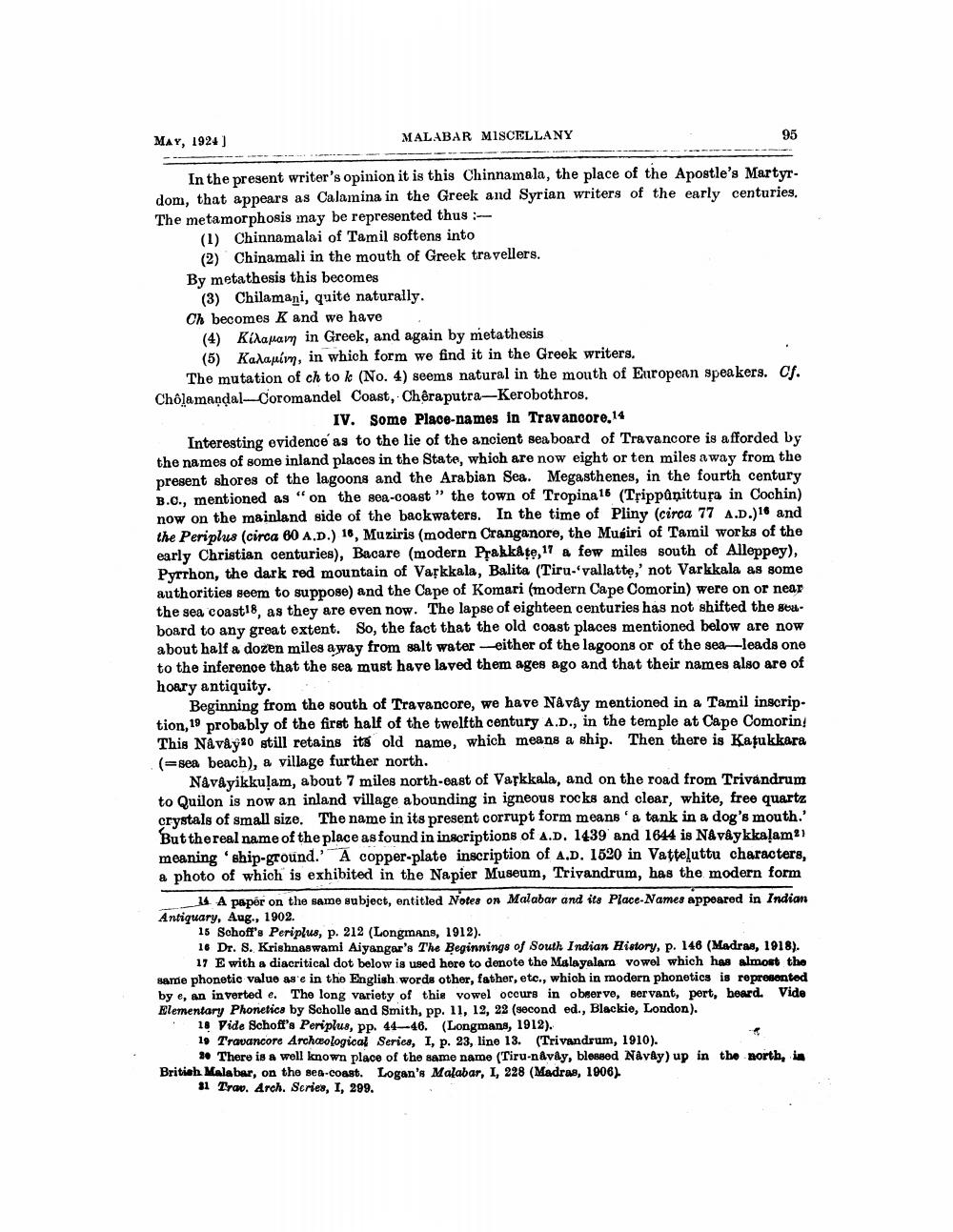________________
MAY, 1924)
MALABAR MISCELLANY
95
In the present writer's opinion it is this Chinnamala, the place of the Apostle's Martyrdom, that appears as Calamina in the Greek and Syrian writers of the early centuries, The metamorphosis may be represented thus:
(1) Chinnamalai of Tamil softens into
(2) Chinamali in the mouth of Greek travellers. By metathesis this becomes
(3) Chilamani, quite naturally. Ch becomes K and we have
(4) Kidapam in Greek, and again by metathesis
(5) Kalapim, in which form we find it in the Greek writers.
The mutation of ch to k (No. 4) seems natural in the mouth of European speakers. Cf. Chôļamaņdal-Coromandel Coast, Cheraputra-Kerobothros.
IV. Some Place-names in Travancore.14 Interesting evidence as to the lie of the ancient sea board of Travancore is afforded by the names of some inland places in the State, which are now eight or ten miles away from the present shores of the lagoons and the Arabian Sea. Megasthenes, in the fourth century B.O., mentioned as “on the sea-coast" the town of Tropina 16 (Trippûņittura in Cochin) now on the mainland side of the backwaters. In the time of Pliny (circa 77 A.D.)16 and the Periplus (circa 10 A.D.) 18, Muziris (modern Cranganore, the Musiri of Tamil works of the early Christian centuries), Bacare (modern Prakkate, 17 a few miles south of Alleppey), Pyrrhon, the dark red mountain of Varkkala, Balita (Tiru-'vallatte,' not Varkkala as some authorities seem to suppose) and the Cape of Komari (modern Cape Comorin) were on or near the sea coast18, as they are even now. The lapse of eighteen centuries has not shifted the sea board to any great extent. So, the fact that the old coast places mentioned below are now about half a dozen miles away from salt water- either of the lagoons or of the sea leads one to the inference that the sea must have laved them ages ago and that their names also are of hoary antiquity.
Beginning from the south of Travancore, we have Navay mentioned in a Tamil inscription, 19 probably of the first half of the twelfth century A.D., in the temple at Cape Comorin This Navaya still retains its old name, which means a ship. Then there is Katukkara (=sea beach), a village further north.
Náváyikkulam, about 7 miles north-east of Varkkala, and on the road from Trivandrum to Quilon is now an inland village abounding in igneous rocks and clear, white, free quartz crystals of small size. The name in its present corrupt form means ' a tank in a dog's mouth.' But the real name of the place as found in inscriptions of A.D. 1439 and 1644 is NAvâykkaļam?) meaning ship-ground.' A copper-plate inscription of A.D. 1520 in Vatteluttu characters, a photo of which is exhibited in the Napier Museum, Trivandrum, has the modern form
14. A paper on the same subject, entitled Notes on Malabar and its Place Names appeared in Indian Antiquary, Aug., 1902.
15 Schoff's Periplus, p. 212 (Longmans, 1912). 16 Dr. S. Krishnaswami Aiyangar's The Beginnings of South Indian History, p. 146 (Madras, 1918).
17 E with a diacritical dot below is used here to denote the Malayalam vowel which has almost the same phonetic value as e in the English words other, father, etc., which in modern phonetics is represented by e, an inverted e. The long variety of this vowel occurs in obhervo, servant, pert, beard. Vide Elementary Phonetica by Sohollo and Smith, pp. 11, 12, 32 (second ed., Blackie, London). • 10 Vide Schoff's Periplus, pp. 44-46. (Longmans, 1012).
19 Travancore Archaological Series, I, p. 23, line 13. (Trivandrum, 1910).
** There is a well known place of the same name (Tiru-navdy, blessed Návky) up in the north, ia British Malabar, on the sea-coast. Logan's Malabar, I, 228 (Madras, 1906)
31 Trav. Arch. Series, I, 299.




